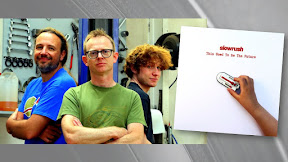The 20-something Bordeaux-based urban explorers are Vincent Bart (also known as Vinjo, brought up in Gradignan in the city’s suburbs) and Pierre-Marie Villette (or Pim, hailing originally from Lille). They launched the website in June 2013 and have so far visited just over 20 of the city’s streets; if they were to continue visiting one street every week, it would take them 39 years to complete their task.
Over recent months I’ve become a loyal reader of one of the city’s most likeable blogs: www.bordeaux2066.com . The concept is simple: the...
Every street tells a story: my afternoon with Bordeaux 2066
The 20-something Bordeaux-based urban explorers are Vincent Bart (also known as Vinjo, brought up in Gradignan in the city’s suburbs) and Pierre-Marie Villette (or Pim, hailing originally from Lille). They launched the website in June 2013 and have so far visited just over 20 of the city’s streets; if they were to continue visiting one street every week, it would take them 39 years to complete their task.
Shortly after launching this website I headed over to the Lac district of Bordeaux to get an idea of where the city would be building its...
An update on Stade Bordeaux Atlantique, the next big sporting arena
At the time it took a great deal of imagination to picture a stadium rising above the trees but now, a little over a year ahead of delivery, the skyline has indeed changed beyond recognition.
For many locals, a day spent in downtown Bordeaux is synonymous with a shopping trip in the Rue Sainte-Catherine quarter, but if you peel...
Les grands magasins : Bordeaux department stores past and present
With this is mind, fellow blogger MystickTroy and I went in search of the department stores of yesteryear with the aim of understanding how strong the influence of the shops of the past continues to be. The account of our quest, which we have jointly published on our respective blogs, starts out at Galeries Lafayette…
Invisible Bordeaux was one of a number of contributors to a lengthy report about the city broadcast by national TV station TF1 during th...
Invisible Bordeaux: as seen on TF1
A mansion in Lormont, just off a narrow road which runs alongside the A10 motorway, forms the backdrop to what is undoubtedly one of the ...
Musée National de l’Assurance Maladie: showcasing France’s healthcare system in Lormont
The spectacular château alone deserves a visit. Known as Les Lauriers, it was built in 1860 and initially belonged to a wealthy dynasty of shipowners, the Gradis family. The Gironde branch of CPAM acquired the property in 1948, converting it into a convalescent home from 1951 onwards. In later years, new facilities were built in the adjacent park, freeing up the mansion to be converted into a museum.
The museum aims to take the visitor on a journey through time. The visit starts out with the beginnings of “la protection sociale” and particularly the development of “sociétés de secours mutuels” in the 19th century, moving on to the first laws passed in the early 20th century, the introduction of the social security system from 1945 onwards, and the development of the system from 1967 up to the present day. This is illustrated by displays featuring hundreds of archive items and documents.
Highlights on the tour include a surprising mock-up of a social security centre as it looked in the 1950s and 1960s, complete with authentic props such as vintage typewriters, telephones, switchboards and rubber stamps. It is tempting to role-play the part of a member of the public meeting staff, filing paperwork and then shuffling over to the counter to obtain the much-desired financial compensation!
Some of the museum’s more bizarre exhibits include ghostly mannequins sporting designer uniforms, symbolising a policy aimed at “humanising” the institution, making it more welcoming and appealing to the general public. Appropriately enough, the mannequins have been positioned at the entrance to the visit.
As well as a visitor booklet, a high-tech audio-guide is available free of charge at reception, to add a further dimension to the tour. The descriptive narration is coupled with authentic eye-witness testimonials by CPAM staff.
 The museum does feel like a well-kept secret; it currently welcomes around 1,600 visitors annually. Its niche appeal is undeniable but there is definitely an audience out there. To reach prospective visitors, director Emmanuelle Saujeon-Roque is developing the museum’s presence on the internet, with an extensive website (featuring videos, a snazzy virtual visit and a host of interactive features) and a Facebook page. The added exposure should deservedly draw new visitors to this unique museum.
The museum does feel like a well-kept secret; it currently welcomes around 1,600 visitors annually. Its niche appeal is undeniable but there is definitely an audience out there. To reach prospective visitors, director Emmanuelle Saujeon-Roque is developing the museum’s presence on the internet, with an extensive website (featuring videos, a snazzy virtual visit and a host of interactive features) and a Facebook page. The added exposure should deservedly draw new visitors to this unique museum. > Find it on the Invisible Bordeaux map: Musée National de l'Assurance Maladie, Château des Lauriers, 10 route de Carbon-Blanc, Lormont
> Museum website: www.musee-assurance-maladie.fr
> And Facebook page.
If you follow Invisible Bordeaux on Twitter , Facebook or Instagram , you may already be aware of the fact that the blog was featured th...
Invisible Bordeaux featured in Direct Matin Bordeaux7
- You can read the full article online here or else in the PDF version of the newspaper.




















4 commentaires: